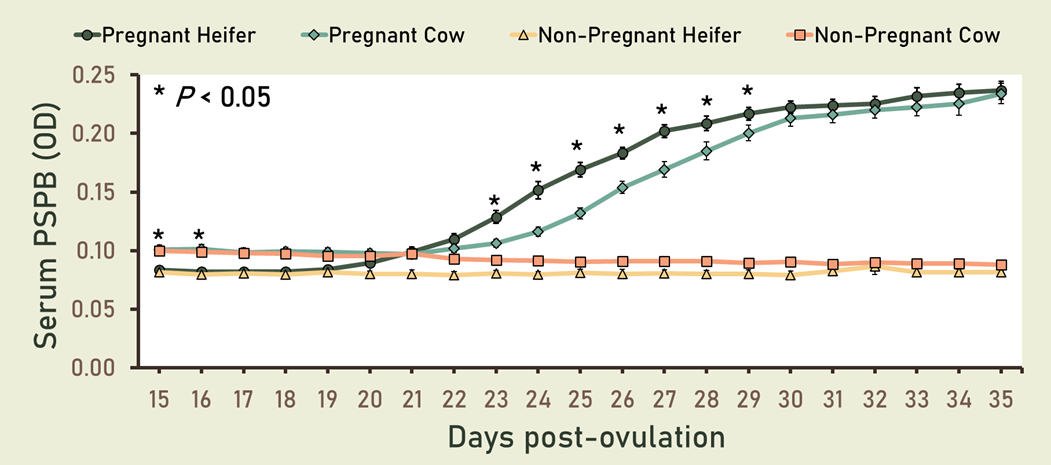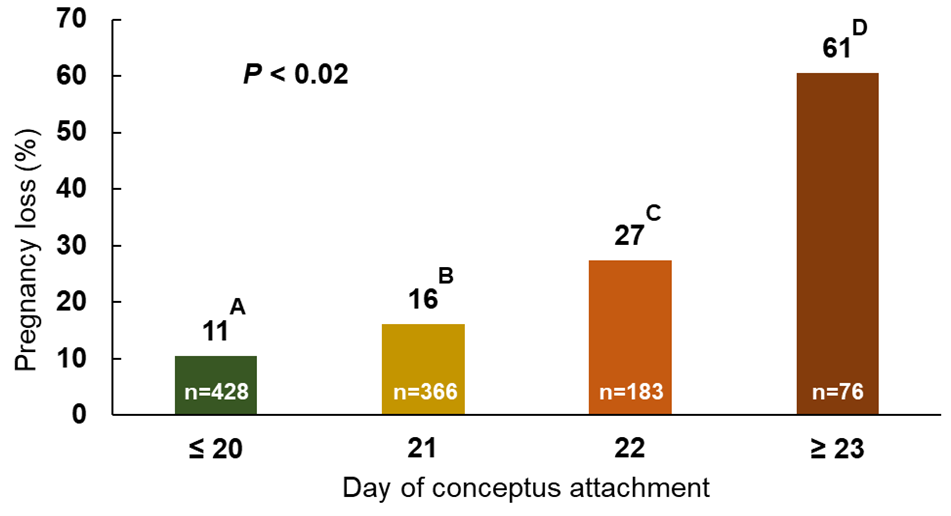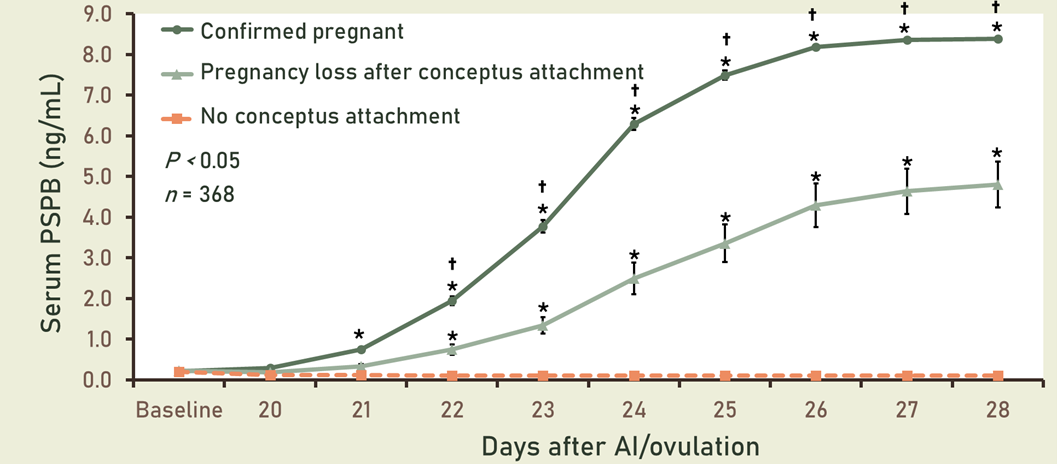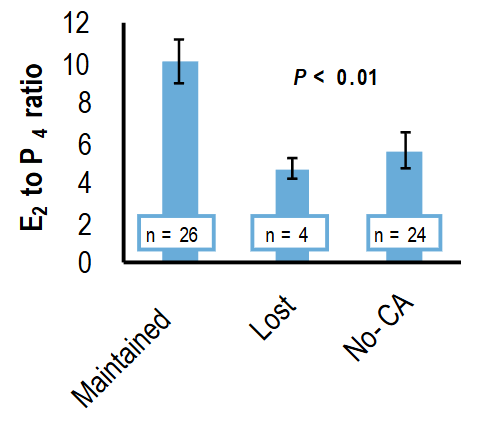Unlocking the key to reproductive success in lactating dairy cows
Drilling down on pregnancy losses to improve herd longevity and farm profitability.

Dairy farming is an intricate balance of maximizing milk production, maintaining animal health and ensuring long-term herd sustainability. At the heart of this balance lies cow reproduction, particularly the challenge of minimizing pregnancy losses after artificial insemination (AI).
Much of our previous work focused on improving fertility programs to enhance pregnancy rates and AI outcomes in lactating dairy cows. Our laboratory recently discovered that while approximately 90% of dairy cows become pregnant after AI, only about 49% remain pregnant 62 days post-AI, even following a fertility program. This points to a staggering early pregnancy loss, especially in multiparous (second or more lactation) cows and worse if bred following a detected estrus.
Most of these losses occur before a 35-day pregnancy diagnosis. These unseen losses represent a major and previously unaccounted for challenge in dairy cattle management. Our current research is focused on identifying the causes of these early losses, with the goal of developing strategies to help save many of these pregnancies and reduce the impact they have on dairy production. While fertility programs like Double Ovsynch and G6G have significantly improved AI success rates, pregnancy loss remains a critical issue.
Farm profit increases when a greater percentage of the herd is in peak milk. For this to occur, greater control of calving interval with optimal reproduction is critical. Cow health and daily herd average milk production can be optimized when a high percentage of cows become pregnant and remain pregnant before 130 days in milk (DIM). Fewer cows calve with excessive body condition loss when this happens. Body condition loss following calving is highly associated with postpartum health problems, a key component of the High Fertility Cycle as denoted in Figure 1, shown above.
Pregnancy losses create havoc with calving intervals because most cows have an extended time to their next estrus. If not detected in estrus these cows will likely be detected at first pregnancy diagnosis. But, if pregnancy losses occur after first pregnancy diagnosis, the chances of keeping these cows in a high fertility cycle become unlikely.
First key finding: Detecting early pregnancy
The first step in gaining a greater understanding of the extent of pregnancy losses in lactating dairy cows was to determine pregnancy near the time of conceptus attachment to the uterus, about 20 days post-AI. Before this, nearly all pregnancy loss data was based on the first pregnancy diagnosis around day 35 post-AI. Recent studies utilized two blood samples tested for pregnancy-specific protein B; PSPB, produced by the conceptus. The conceptus is made up of the embryo and the cells responsible for maternal/fetal interaction. An increase in PSPB indicates the conceptus has attached to the uterus. One blood sample was collected before the expected initial increase in PSPB and another after the increase had occurred to calculate the increase from baseline. We were 100% accurate in diagnosing pregnancy at this time as depicted in Figure 2, below. We now refer to this increase in PSPB as “conceptus attachment.” Most cows that have conceptus attachment have this increase in PSPB around day 20 or 21 post-AI.

Second key finding: Cows that have delayed time to conceptus attachment will likely have pregnancy loss
We found that cows can experience an initial rise in PSPB anytime between days 19 and 26 post-AI. The later this increase occurs, the greater the likelihood of pregnancy loss as depicted in Figure 3, below. This suggests either a developmental problem with the conceptus that occurs at the time of fertilization, a uterine issue, or a combination of both.

A key indicator of this developmental problem is the reduced average concentrations of PSPB in cows that lose vs. maintain pregnancy as depicted in Figure 4, below. Multiparous cows are more likely to experience delayed attachment and subsequent pregnancy failure.

Third key finding: The ratio of estrogen to progesterone in the dam’s circulatory system prior to conception is a key indicator of embryonic survival
Our laboratory has demonstrated that pre-conception factors, such as the diameter of the ovulatory follicle and circulating concentrations of estrogen and progesterone before ovulation, can significantly impact subsequent pregnancy outcomes in cattle. These factors may influence the oocyte directly or affect the uterine environment during early embryonic development.
In a recent study we found that cows that maintained pregnancy had a two-fold greater estrogen to progesterone ratio in maternal circulation at the time of the final GnRH injection of the Double Ovsynch protocol, compared to cows that either did not become pregnant or lost pregnancies after conceptus attachment as depicted in Figure 5, below.
.png?language_id=1)
The antral age of the ovulatory follicle is also crucial for both embryonic development and pregnancy maintenance. Recent data from our laboratory suggest that a prolonged antral age of the ovulatory follicle reduces the likelihood of pregnancy and increases the risk of pregnancy loss. Cows with an extended antral age of the ovulatory follicle also had larger follicle diameters, which have been linked to reduced fertility outcomes.
Specifically, larger follicle diameter is associated with decreased pregnancy rates following artificial insemination (AI) and higher pregnancy losses. This is a particularly important concern in multiparous cows that undergo AI after estrus detection, as these cows typically have larger ovulatory follicles compared to those treated with fertility programs like Double Ovsynch. The unnecessary culling of multiparous dairy cows results in decreased herd average milk production, increased replacement costs, and diminished operational efficiency. Approximately 50% of cows leave the herd before their third lactation.
In a recent comparison between the Double Ovsynch protocol and estrus detection using electronic monitoring for first AI, we observed that cows receiving the Double Ovsynch program had significantly greater pregnancy rates within the first three weeks following the voluntary waiting period. Notably, multiparous cows had a 260% greater chance of becoming pregnant during this period.
Our data suggests careful timing is key to help reduce pregnancy losses in multiparous cows. These cows should ideally receive their first AI before 85 days in milk with the goal of a 50% pregnancy rate by the initial pregnancy diagnosis around 35 days post-AI. Early pregnancy in multiparous cows has far-reaching benefits beyond the immediate lactation, including reduced body condition loss at calving, lower incidences of postpartum health issues and improved fertility during the next lactation. These cash cows represent the backbone of farm profitability.
Searching for ways to decrease pregnancy losses: Could increasing progesterone post-AI help solve this problem?
Previous data suggested that progesterone supplementation and level of progesterone post-AI could improve embryonic survival. We found that increasing progesterone levels post-AI had no significant impact on pregnancy success or loss rates. In fact, multiparous cows with greater progesterone concentrations experienced greater pregnancy loss rates compared to those with lower progesterone levels.
This counter intuitive finding suggests that progesterone supplementation may not be the silver bullet it was once considered. In fact, it raises the possibility that other factors—such as the timing of conceptus attachment or the general health of the reproductive tract—are more influential in pregnancy maintenance. The data highlight that other strategies may be needed to improve pregnancy outcomes rather than simply focusing on progesterone levels. This also indicates that a functional corpus luteum producing normal amounts of progesterone is sufficient for embryonic development prior to conceptus attachment.
The mission of the Pursley Lab is to advance the understanding of dairy cattle fertility and develop innovative reproductive strategies that enhance the profitability of dairy farms. We continue to investigate the underlying causes of pregnancy loss and develop new practical strategies to improve pregnancy survival in dairy cattle. Want to learn more? Find them on YouTube, @pursleylabmsu5805 or visit dairycattlereproduction.com



 Print
Print Email
Email





